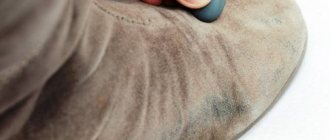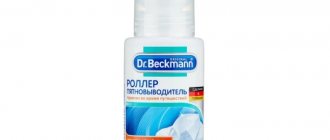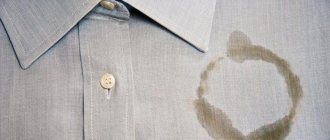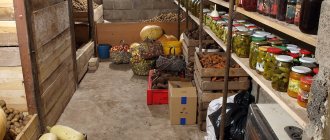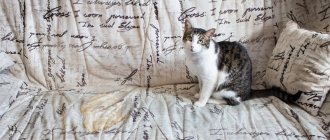Methods for removing greasy stains from a down jacket
A down jacket is one of those things that does not like frequent washing - after just a few treatments it can lose its attractive appearance, become stained, wrinkle, etc. Therefore, housewives prefer to remove traces of fat from it locally, i.e. only in the area of the contamination itself without subsequent washing.
The option of dry cleaning an item will not be cheap, and if you consider that with constant wear the item quickly gets dirty, then such periodic cleanings will cost a lot of money. The best option is to remove fresh greasy stains; they come off easily
But there are times when it is not possible to notice dirty marks on a jacket, and attention is paid to them after some time, when the fat has already eaten into the fabric and dried out. Even in such a severe case, there is salvation - some special stain removers prepared according to folk recipes can easily cope with such a problem
If the method requires additional mechanical action (wiping the stain with the mixture, rather than applying it normally), it is important to follow one simple rule: move from the edges of the blot to the center. This will help avoid streaks and streaks.
In addition, all residues of any product used must be removed after treatment.
After some means of cleaning the down jacket, subsequent washing becomes inevitable. Of course, you can try to remove the stains that appear after treatment by rinsing a large area of the area, but often this does not change anything.
General recommendations
Bolognese fabric is a traditional material for sewing primarily outerwear. The fabric got its name from a small town in Italy. It was there that it was made for the first time, and now it is produced in many countries.
The fabric is multi-layered. When producing bologna, the composition is applied in several layers to the reverse side of a nylon or nylon base. The first layer is a viscous composition of polymer components and acrylic acid with the addition of auxiliary substances that ensure the waterproofness of the fabric.
The second layer creates an attractive appearance. Next, the fabric is treated with a substance containing metal powder, creating a protective film to improve its quality.
Removing a greasy stain from a Bolognese jacket is not so easy precisely because the fabric is multi-layered with a multi-component composition. There are some general recommendations that allow you to remove a greasy stain from a jacket without leaving any residue:
- It is easier to remove fresh grease or oil stains from the surface of the fabric;
- Before starting the procedure, you should read the instructions on the label;
- establish origin;
- processing should begin from the inside of the product if it is light;
- avoid soaking;
- eliminate intense friction.
A jacket, especially one with down filling, does not like frequent washing, since the product can quickly lose its appearance. That is why many housewives prefer to remove stains locally, that is, only from the site of contamination.
It is important to determine the origin before washing.
This is necessary in order to choose the optimal cleaning product. It is important to understand that this stain is greasy. Signs of oily contamination on bologna:
- uniform shade intensity, regardless of the edge or center of the spot;
- the color is several times richer than the color of the product itself;
- the fresh stain is much darker than the bologna fabric;
- old contamination has a matte color.
To remove stains on a Bolognese jacket, you need to prepare cotton pads, a clothes brush with soft bristles, paper napkins, and foam sponges.
Effective ways to clean your jacket from grease stains
Carefully study the information on the label and determine the type of fabric so as not to damage the material by intensive washing or inappropriate products.
Textile products
Jackets made from delicate fabrics cannot be washed in a washing machine. Hand washing and soft products will help you cope with stains:
- A small stain can be removed by using an iron and a thin cotton cloth or soft paper through which the stained area is ironed. The high temperature will soften the fat and the stain will disappear. You should act carefully, not to go beyond the fabric or paper, so as not to damage the thin fibers. The thermal treatment method will help to cope with candle marks.
- Baby powder is great for removing fresh oil marks from a suede jacket. The product is mixed with water until a paste forms, applied for 5-10 minutes, the residue is thoroughly removed with a soft brush.
- Powdered chalk works similarly to powder if you rub it on the dirty area for a few minutes. Remove any residue with a clothes brush.
- White textile items are cleaned with ammonia. A solution in the proportion of 1 tsp. Apply 200 ml of water to the problem area with a cotton pad and leave until completely dry. If necessary, the procedure is repeated.
Things from Bologna
Clothing made from Bolognese fabric has a number of advantages. Nylon raincoats and membrane jackets protect from rain, strong winds, and with the addition of synthetic padding, they save you in cold weather. Cleaning Bolognese clothing is not difficult - provided that action is taken immediately. You need to treat the fabric with a cleaning agent from the wrong side.
- Onions will help remove fresh greasy marks on colored clothes, lemon - on light-colored ones. A cotton pad is moistened with plant juice, and the area of contamination is carefully wiped. To get rid of the smell, the dried, cleaned area can be washed several times with a cloth soaked in water.
- Mustard powder diluted in water (2 tsp per volume sufficient to obtain a thick consistency) can remove an unpleasant greasy stain. Apply, leave for several hours, wash off the dried residue with water, and dry.
- Potato starch removes greasy stains from down jackets. The contaminated surface should be rubbed thickly, sprinkled on top and left for several hours. Remove any remaining starch with a dry cloth.
- Glycerin, which does not contain aggressive substances dangerous to the structure of the fabric, will cope with greasy marks on clothes made of Bolognese fabric or a leather jacket. The product is applied to the dirty area using a cotton swab. After 30 minutes, wipe the surface with a damp cloth.
Each method is suitable for quickly and efficiently washing a winter jacket from greasy stains.
Remove strange, wet and dirty
You can remove stains of unknown origin in the same way as fat stains. Treat them with a solution of wine alcohol, sulfuric ether and ammonia. The ether can be replaced with acetone or another solvent. It is acceptable to use an alcohol solution of soap.
Oxygen bleach will help get rid of contaminants of unknown nature:
- Pour the product into a container with water and soak the product in it;
- Leave until the stains disappear;
- Rinse well.
Soap and laundry detergents work well to remove water stains. Here are the methods you can use:
- Lemon juice helps remove water stains. Apply the product to the problem area. Suitable for cleaning jackets and down jackets;
- To remove a wet stain, apply a solution of detergent to the stain, then scrub the area with a brush to create a lather. Wait five minutes and rinse with water. Dry with cold air.
How to remove an old grease stain
The very first thought that comes to the mind of any housewife who first encounters a greasy stain on a Bolognese jacket is why not wash it in a machine with a stain remover.
Indeed, this method will clean outerwear, but what if it can only be washed by hand? This is where other stain removal methods can come to the rescue.
Petrol
Purified gasoline is perhaps the most powerful agent that is guaranteed to remove any contamination from bologna, but will reward it with a pungent, memorable odor for a long time.
It is recommended to use this method only if the jacket is not needed urgently, because after such treatment it will need to be aired for several days.
So, soak two small pieces of cotton fabric in gasoline and apply them to the greasy stain on the front and back sides of the product. Wait 20-30 minutes, then remove the material and thoroughly walk over the area of contamination with a brush soaked in laundry soap.
Ammonia
To quickly get rid of a greasy stain that appears completely unexpectedly, you can use ammonia. However, this method is not suitable for dark jackets, since along with the dirt, the product can “eat” the color.
So:
- dilute 1 tbsp. l. ammonia in 6 tbsp. l. warm water;
- soak the brush in the resulting solution and rub the stain well;
- wait 15-20 minutes;
- Wash the area to be treated using washing powder or laundry soap for additional cleaning.
By the way, after the jacket is wrung out by hand, you can quickly dry it with a hairdryer. This will save time, which is especially important if outerwear needs to be cleaned urgently.
Mustard powder
Dry mustard can cope with grease on outerwear if it is first diluted with slightly hot water. Take 2 tbsp. l. dry product and add enough water to them to make a paste.
Apply it with a clean toothbrush to the stained area and leave until completely dry. Once the mustard has hardened, manually shake the remaining mustard into the sink and scrub the surface thoroughly.
Potato starch
Potato starch will quickly absorb fat if it is preheated. You can do this in two ways:
- in the microwave;
- using an iron.
If the product is heated in advance, it should be applied to a dry jacket. If the starch does not warm up, then the cleaning area can be pre-wetted using a spray bottle.
After the stain has been generously covered with this “powder,” it should be covered with tracing paper on top and ironed well. This is done so that the grease from the jacket moves to the paper and starch, and the surface being treated is finally cleaned.
Chalk and laundry soap
If you don’t have starch on hand, but you have children’s crayons at home, they can also be used to remove grease stains from bologna. But you should only take white chalk, since colored chalk can change the color of the material:
- using a knife, crush 1/3 of the chalk to a powder;
- apply it to the pre-moistened stain;
- iron the stained area using tracing paper;
- wash your jacket with laundry soap.
At the same time, to ensure that there are no streaks left on outer clothing, if it has been partially washed, finally wipe the item with vinegar.
Onions or lemon
If you need to remove a greasy stain on a light bologna product, then the juice of one or two lemons will come to the rescue. To do this, citrus fruits are washed well under running water, cut in half, after which the juice is squeezed out of them.
The juice is applied to the stain, after which the lemon is given time to react with the fat. This usually takes no more than 40 minutes. After this, the jacket is washed either with laundry soap or bleach.
If the product is dark in color, then onion juice will come to the rescue, which is also squeezed out of several onions. The juice, in the same way as in the previous case, is applied to the item, remains on it for at least 40 minutes, after which it is washed off either manually or in a machine.
Dentifrice
If you have dry tooth powder in the house without any additives, then it can be used to remove greasy stains from a Bolognese jacket. Simply apply the powder to a pre-wetted stain and rub it vigorously with a brush.
So, greasy stains on a bolognese jacket are not a reason to give up your favorite item. It is enough to spend just one evening and put it in order so that you can wear your favorite outerwear with pleasure again.
Preparing for cleaning
You need to act carefully so as not to spread the contamination all over your clothes. At the initial stage, it is important to remove excess grease stains from the product as quickly as possible. If you don’t have special tools at hand, you can use any of the following. How to remove unabsorbed fat:
- Wipe the area with a damp cloth.
- Sprinkle the grease mark with salt. Wait 5 minutes and shake off any remaining substance.
- Apply baking soda to the area and rub in gently. Leave for 5 minutes and remove the powder.
- White chalk. Draw a blot on the jacket and leave until thoroughly cleaned using special products.
- Rub bread crumb into place of fat.
These simple techniques will greatly facilitate the process of removing grease stains from a Bolognese jacket.
For the main cleaning stage you may need the following equipment: warm water; soft sponge; cotton swab; wooden plank covered with colorless fabric.
When removing stains from a bolognese jacket, it is recommended to work only from the reverse side to avoid damage to the product and the spread of the stain.
Rules for removing grease stains and useful tips
Before you begin cleaning up the stain, it is recommended to correctly determine how to get rid of the stain and which method will be more appropriate for a particular type of fabric. It is then recommended to properly prepare your clothes by following these tips:
- If a stain appears on a sheepskin coat or suede jacket, it is initially recommended to vacuum them and remove all particles of dust from the contaminated area using a special brush for cleaning suede.
- If dirt gets on a leather jacket, first wipe it with a damp cloth.
- In order to wipe off grease stains from a tanker, down jacket or bologna jacket, they must first be thoroughly dusted off.
- If a greasy stain has just appeared on white or colored clothing, it is recommended to immediately remove it and put it in the washing machine to prevent it from becoming old. Such urgent measures will help prevent the blot from spreading and fat from penetrating into the deeper layers of the tissue.
- If the grease stain on light or colored clothing is already old, then such things should also first be rid of dust by wiping them with a laundry brush.
- Having prepared your clothes, you should prepare a means with which you will combat the trouble that has arisen. As well as a sponge, cloth or other rag with which the cleaning agent will be applied to the dirt.
Let's look at the most effective ways to remove grease stains from various types of clothing.
Removing unabsorbed fat
Did your child decide to eat a fried pie on the street and stain the cuffs of his jacket? Did your spouse accidentally stain his sleeves just by tinkering a little under the hood of the car? Such fresh stains are the easiest to remove, because they have not yet eaten into the material.
And the fastest way to eliminate them is ironing. You will need:
- tracing paper;
- iron;
- 10-15 minutes of free time.
Place the jacket on the ironing board so that its sleeves and other parts do not roll off the surface. Plug the iron into a power outlet and set it to the program that the manufacturer's label allows.
Place tracing paper on the fresh grease stain and gently iron it. After all the fat has transferred to the thin paper, turn off the iron and move to the bathroom.
Take the stain remover, dilute it in water according to the instructions, and soak your outerwear for 30-40 minutes. After that, either rinse it or put it in the washing machine.
Removing fresh traces of grease
It is absolutely clear that fresh stains are washed off much better. Therefore, a lot depends on how quickly we begin to act. I can’t help but remember the legendary phrase from my favorite movie: “We urgently need to sprinkle it with salt. Take off your dress! But here is a hint that you don’t always need to rush to wash it, there are other ways. And although, unlike the heroes of “Office Romance,” we are not thinking about the stain of wine, but about how to wash a greasy stain on clothes, salt is also useful.
Adviсe
- SALT
Salt is universal. With its help you can easily remove any dirt without much effort. It is only impossible to remove old or stale stains after washing.Sprinkle a pinch of salt on greasy stains from clothes. Gently rub in until the salt is saturated with fat. Repeat these steps, replacing the salt with pure salt, until all the fat is absorbed and completely disappears. Then wash off the greasy stains in a machine or by hand in the usual way.
DETERGENT
It works great on dishes. But how to get rid of greasy stains on clothes with its help? A stain on a T-shirt, pants and other things can be easily removed with just a drop of detergent. However, if the area of contamination is large, more than one drop will be required. Leave for a few minutes and rinse with hot water. Then wash the item.
ALCOHOL
It is quite possible to remove oil and mulberry stains from clothes using ammonia: this remedy also helps in many other cases; for this, add 1.5-2 tsp to a glass of warm water. alcohol Wet a cotton swab and lubricate the problem area. You can completely remove the fat by ironing the product through a cotton cloth with a warm iron.
POTATO STARCH
How to remove a vegetable oil stain from clothes without washing? Rub in starch and wait 5-15 minutes. Repeat until the oil stain disappears from clothing.
MUSTARD
Mustard can help too. Before removing grease stains from jeans and colored clothes, dry mustard is diluted with warm water to the consistency of sour cream and applied to clothes for half an hour. Then the product needs to be washed. Complete removal of greasy stains, if they have dried out or are completely old, with the help of mustard will occur if it is heated.
SHAVING FOAM
Many bachelors know how to remove an oil stain on trousers quickly and without consequences. For them, removing dirt is not a problem if they use shaving foam. Foam is rubbed into the contaminated area, and after 5 minutes the clothes are washed with regular powder. And the greasy stain on the jeans is gone!
CHALK POWDER
And chalk powder will help remove old grease stains from light-colored clothes and not leave a yellow residue. It is crushed and carefully distributed. Leave on clothes for at least 2 hours. You can remove the powder with a cloth soaked in warm water. Now the item can be washed.
TALC, TOOTH POWDER
Another way to remove oil stains from light-colored clothes. This method is more suitable for wool products. Distribute talc or powder on the problem area. Cover with tracing paper and iron with a warm iron. To completely remove fat, press the clothes with a heavy object overnight.
BLOTTING PAPER
You can also remove old grease stains from clothes using blotting paper and a warm iron. Place the clothes with paper, top and bottom. Iron it. If you can’t get rid of it right away, remove the paper, replace it with a new one, and repeat the procedure.
LAUNDRY SOAP
But how to remove an oil stain from clothes using laundry soap? There are 2 ways: - just lather the problem area well and leave it for a day. In the morning, soak the item and wash it; if the dirt does not come off, repeat the procedure—and the second method is more aggressive. Lathering up. After a day, wash the item, soap it again, sprinkle with sugar and rub with a brush.
BOILING WATER WITH VINEGAR
How to remove mulberry marks and blots? For this you need simple boiling water. Water the problem area with a stream of hot water acidified with vinegar. This method is only for products made from natural fabric.
BREAD AND DETERGENT
Even using a crumb of bread can remove a greasy stain on jeans. Press the bread onto the dirt on the jeans. Then dilute the detergent in warm water and wash.
Basic Rules
The first and basic rule to remember is that almost all types of stains are easier to remove while they are fresh. In the first 30-120 minutes, it is enough to spill or wash the stain with water or a damp cloth.
However, there are exceptions. So, it is better not to try to clean fresh dirt and drops from a melted candle, so as not to smear them. In the first case, you need to let the clothes dry and brush off the dirt with a brush. In the second, try to apply low temperature to the soiled items; the wax will harden, become brittle and be easily removed.
The next important point: before removing a stain from clothing, you need to make sure that the stain remover is safe for the material. To do this, apply a drop of the product to the hem of the bottom or in another inconspicuous place. If the tissue does not change, then the product can be used.
Before washing, it is important to study the composition of the material given on the product label. There are also rules of care that cannot be violated. For example, if a product can be washed at 30 degrees, then you should not try to remove the stain by pouring boiling water on it.
If there is a symbol on the label that says the product cannot be washed, then it is better to take it to the dry cleaner without trying to remove the stain at home.
Need to remember:
- It is prohibited to clean synthetic fabrics with organic solvents;
- artificial silk will be destroyed by acids, solvents, and hydrogen peroxide;
- dyed fabrics are likely to become discolored when treated with hydroperite solution or chlorine bleach;
- Eco-leather cannot be treated with organic solvents.
You need to handle silk, lace and wool items very carefully.
Procedure
It is not recommended to use concentrated products to remove stains; it is better to dilute them with water. A substance that is too aggressive will negatively affect the fabric. If the trace is not cleared on the first try, the processing can be repeated.
To remove a stain you need to:
- turn the thing inside out;
- straighten it by placing a white cotton cloth folded several times on the front side under the stained area;
- aggressive stain remover should not be poured onto the fabric; you should moisten the swab and carefully treat the stains;
- you need to move strictly from the edges to the center, otherwise the mark will only increase in diameter;
- and to prevent a dirty halo from appearing on your clothes from smeared stain remover, you should sprinkle starch, talc around the perimeter, or at least moisten it with water;
- If hard brushing is required, it is better to use an old toothbrush.
Work should be carried out in a well-ventilated area, preferably in bright sunlight.
To effectively get rid of a stain on clothing, you need to understand its type. For example, recipes for greasy stains and paint marks will be different.
Various factors can provoke the appearance of dirt on wardrobe items. The most noticeable are those that arise due to dyes, fat, and exposure to salts. The list of components that contaminate tissues is endless, but many “blots” have similar properties. Therefore, before removing a stubborn stain, you need to determine the type of contamination:
- water-soluble (stains from sauces, soups, mustard, any other food stains);
- insoluble (stains from soot, construction mixtures, coloring pigments);
- soluble in solvents (grease and wax stains);
- removed only with special reagents (stains from blood, rust, nail polish, oil paints).
The type of dirt affects the choice of cleaning and washing method for the product. Another important condition for dealing with stains is the correct determination of the material from which the clothes are made. Aggressive preparations, such as acetone and vinegar, cannot be used to remove stains from nylon, acetate fabrics, and polyvinyl chloride fibers.
It is difficult to prevent stains from appearing. Even the neatest people who take very good care of their wardrobe are not immune from unpleasant accidents. Manufacturers of household chemicals have developed and offered customers a number of impregnations intended for treating fabrics.
Compositions with water-repellent properties are often used, which can be used to treat both natural and synthetic fabrics. Afterwards the material continues to “breathe”. An invisible film forms on its surface, which prevents the penetration of water and prevents the occurrence of contamination. Impregnations are applied to fabrics as follows:
- The item is positioned so that creases and folds do not form on it.
- The container with impregnation is shaken and distributed in the hands with the spray upward in a vertical position.
- The bottle is located at a distance of 20 cm from the surface to be treated.
- The liquid is sprayed until the product is completely wet.
We suggest you familiarize yourself with How to sew a sleeve on a jacket with a hidden seam
Clothes should be completely dry after this treatment. After each wash, these steps will have to be repeated again and again. Impregnation reliably protects clothes from rain and dampness, dirt and oil-containing liquids.
Removing greasy stains with folk remedies
You can easily get rid of fresh dirt using natural remedies. Let's look at the most common methods.
Laundry soap
This method is especially suitable for fresh stains that have not had time to be absorbed. To do this, you need to soap the contaminated area as soon as possible and leave it to soak for 12 hours. In this case, it will be most effective to wrap it in plastic film or cellophane. Afterwards you can wash the item as usual.
By adding sugar to laundry soap, the time to remove a greasy stain will be significantly reduced and will take about 15 minutes. Lather the stained area, sprinkle a little granulated sugar and scrub with a brush. After 15-20 minutes, the clothes can be washed as usual.
Salt
As soon as you notice a stain, immediately pour salt in large quantities onto the stained area. After 15-20 minutes, the salt will absorb most of the fat and all that remains is to wash the clothes.
Chalk
Chalk can remove grease stains from light natural fabrics. Just sprinkle the area with powdered chalk and leave it there for about 2-3 hours. Use a damp cloth to remove any residue and wash the item as usual.
Toothpaste or powder
You can get rid of grease on woolen items using regular tooth powder. Apply the product to the area, place a blotting pad or tracing paper on top and iron the clothing. Next, put a small pressure, for example, a few books and leave it overnight. In the morning, wash the item according to your fabric type.
Blotter
Place a sheet of blotting paper on the front and back sides of the stained area and iron with a warm iron. It is necessary to do a similar procedure several times so that the fat is completely absorbed into the paper.
White bread
Apply the crumb of white bread to the stain and leave until the fat is absorbed. Afterwards wash in warm soapy water. This method is especially suitable for velvet products.
Ammonia solution
Dissolve a teaspoon of ammonia in a glass of water. Apply the prepared solution to the contaminated area, place a clean cotton cloth on top and iron with a warm iron. In this case, the fat remains on the fabric.
Mustard powder
Mustard powder perfectly removes greasy stains from linen products. To do this, you need to mix the powder with water until it becomes sour cream. Apply the prepared mixture to the stain and leave for 50 minutes. Afterwards you can wash with warm water.
Starch
It happens that a product cannot be washed, but there is already a greasy stain on it. In this case, starch will help greatly. You need to rub the product into the contaminated area for 1-2 minutes and leave for 10 minutes. The procedure must be repeated until complete cleansing.
Dishwashing liquid
In addition, you can deal with dirt on any product using a dishwasher: dishwasher powder or liquid dishwashing detergent. It must be applied to the stained area, left for 10-15 minutes, and then washed.
Shaving foam
To do this, apply the foam to the product, rub it into the fabric with light movements and leave for 5 minutes. After which you can wash it in the usual way.
Gasoline and alcohol
Alcohol, gasoline and turpentine will help get rid of any type of contamination
The main thing to keep in mind is that such compositions must be used carefully and carefully. Do not apply them to the fabric for more than 2 minutes.
This is due to the fact that the components of any of these products can begin to destroy the structure of the fabric, thereby ruining the item.
However, such compositions must be used only in their pure form, for example, purified gasoline, pure or medical alcohol. Otherwise, technical contamination will appear on the product, which will be much more difficult to remove.
Removing fresh stains
There are much more products that can be used to remove fresh greasy marks on clothes, and in this case you need to start with the least aggressive ones. Let's look at the main methods:
- Laundry soap. It definitely exists in every home. An old, proven remedy that has more than once helped housewives in the fight against various types of pollution. In the situation with fat, it is also relevant. To remove, you need to soap the contaminated area and rub with a soft sponge. After this, you can wash off the soap traces and rinse.
- Mustard powder. Prepare a solution from equal amounts of powder and water. Gently rub the resulting slurry into the fat and leave to act for 45-60 minutes.
- Dishwashing liquid. One of the simplest and most affordable options. To do this, immediately after the appearance of grease, drop a small amount of detergent and rub a little. After this, be sure to wash the entire product in soapy water.
- Onions and lemon. These two components dissolve fat and lighten the traces of fat somewhat. To prepare the product, you need to chop the onion head to a paste. Add the juice of half the lemons to the prepared mixture. Apply the resulting slurry to the blot and leave for 30 minutes.
- Starch. Suitable even for items that cannot be washed. To clean, pour the powder onto the stained area and place a clean white sheet of paper on top. Iron the area with an iron. If all the stain does not go away the first time, the procedure can be repeated, each time changing the paper to clean one. Potato or corn starch can be used.
- Toothpaste. It is desirable that it be white. Others may leave colored marks on clothing. Wet the fat on the jacket, apply the ingredient and foam thoroughly. Leave for 30 minutes and rinse with warm running water. Then you can wash the item as usual.
If you don’t have time to use any special methods to save outerwear, then you can do a classic wash using washing powder. To remove the stain, you need to additionally lubricate it with a slurry of detergent. This mixture has a higher concentration of active substances and will be able to cope with a difficult task.
How to remove old grease stains from clothes
To remove old grease stains from your clothes, you don’t have to buy expensive powders and gels. You can remove contamination using simple products that are found in every home.
Laundry soap
The first assistant in the fight against greasy marks is laundry soap. The method is suitable for any type of fabric. Take a bar, lather it on the problem area and leave it for a couple of hours. After that, start washing. If the stain is not removed on the first attempt, you must repeat the procedure.
Salt
Another helper is table salt. Fill a basin with hot water, add 1/2 cup of salt and soak the clothes with the greasy stain for 2 hours, and then wash the items as usual.
For a more effective effect, mix salt with ammonia. For 1 teaspoon of salt there are 6 teaspoons of alcohol. We treat the surface of the fabric with the mixture, leave it until dry and proceed to washing. However, keep in mind that this method is not suitable for clothes that fade.
Petrol
The next remedy is gasoline. Take tracing paper, moisten it in liquid, place it on the contaminated area from the wrong side and press down, while also moistening the front side of the fabric. If you don't have tracing paper, use some other blotting paper. If the fat does not come off onto the tracing paper, you need to leave it for a day.
After this procedure, clothes should be washed thoroughly and left to dry completely in the fresh air to get rid of the smell. Gasoline can also be replaced with acetone.
Warmed starch
To remove old stains, use hot starch. It is heated in a water bath and the dirt is sprinkled on it, a napkin is placed on the inside, which will absorb the fat.
Starch must be rubbed well into the fabric and replaced with fresh starch as it becomes dirty. The procedure should be repeated several times until the stain completely disappears. After this, the item is washed with soap or powder.
Turpentine and ammonia
A powerful weapon in the fight against greasy stains is a mixture of turpentine and ammonia in a 1:1 ratio. Treat the contaminated area with the solution and leave for a couple of hours, then wash with laundry soap.
Ammonia is also mixed with water in proportions of 1:2; this method is suitable for light-colored items.
Ethanol
A good stain remover is rubbing alcohol. To remove the stain, dampen it with ethanol several times. The procedure must be repeated at least every hour. You don't have to worry about the smell of alcohol. There is no need to get rid of it; after a while it will go away on its own.
Glycerol
Another way to remove grease stains is to use glycerin. Heat the substance and generously wipe the stain with it. Residues are removed with gasoline, after which the item is washed as usual.
Wood sawdust
At home, you can wash off a greasy area using sawdust soaked in gasoline.
Place sawdust on the greasy stain and leave until the gasoline dries completely. Once the substance has dried, remove the sawdust and start washing. The method is most suitable for furniture and carpets.
When choosing a homemade stain remover, you need to consider the type of fabric from which old traces of grease are removed. Some products are great for some materials, but can irrevocably damage others.
Features when removing old and fresh stains
To remove a fresh stain from a bolognese jacket, you should use a soft cloth, a cotton swab or pad, or the softest brush.
If possible, processing should begin from the wrong side of the product. When cleaning, movements should be directed from the edge of the stain to its center to prevent the spread of moisture.
Before starting cleaning, you need to blot the stain with a dry paper napkin as quickly as possible to prevent the contamination from spreading further. Then you should apply salt or talc. These substances will absorb some of the fat. Next, you can start cleaning the jacket.
Folk remedies often use ammonia, lemon juice (for light-colored fabrics), and laundry soap. Antipyatin in the form of a gel, spray or powder is effective against fresh stains.
Removing old grease stains will require a lot of effort. The dirt will need to be pre-soaked so that it is moistened with the product, and then cleaning can begin. Among chemical products, gels and sprays from Amway, Vanish, and Antipyatin show good results.
Other products that are quite effective include tar soap, gasoline, dishwashing gel, turpentine and glycerin.
Use a piece of fabric that is sold with the product. Usually the manufacturer attaches it to a label on the inside of the jacket, along with spare buttons or snaps. Before cleaning the product, you should test the product on this fabric to make sure that the color does not change.
How to remove a greasy stain on a jacket using traditional methods
Removal of greasy stains occurs according to the principle from weak to strong - first try products with a mild effect on the fabric. Only then do they move on to deeper cleaning methods. Despite the fact that improvised products are gentler than industrial stain removers, it is also recommended to test them on small samples of fabric so as not to damage items made from delicate materials.
How to remove grease stains from a jacket with starch
You can use potato or corn starch to remove fat. It is diluted with water until a thick paste forms and applied to the stain. After half an hour, the starch is removed with a damp cloth.
Important! At the same time, you should not rub the greasy stain or its residues too hard. The substance is removed with careful blotting movements.
How to wash a jacket from grease stains with soap
Laundry soap is best suited for these purposes. They need to soap the dirty area and rinse the product, but they can also sprinkle the stain with soap shavings for 20-30 minutes. Then the item is washed to remove any remaining dirt.
How to remove an old grease stain from a jacket with baking soda
Baking soda is usually sprinkled on fresh stains to quickly draw out the grease from the fabric. Baking soda is unlikely to remove old stains, but it can be used effectively on a leather product.
How to remove a greasy stain on a jacket with mustard powder
1 tsp. mustard powder is mixed with 1 tsp. water and apply to the contamination. The method is universal and suitable for almost all types of fabric. With the help of mustard you can remove fat even from leather products.
How to remove a greasy stain from a jacket with ammonia
Ammonia effectively removes old grease stains. To do this, it is mixed with table salt and water in a ratio of 1:1:3, applied to the contaminated area and left until completely dry. Then the product is washed by hand or in a machine.
How to remove a grease stain from a jacket with toothpaste
In order to remove fat from a jacket, squeeze a small amount of toothpaste onto the stain and spread it in a thin layer. After 2-3 hours, the item is rinsed and washed.
Advice! For white fabric, it is better to use a light paste, as colored paste may leave marks on the jacket. A product with a bright print is treated with gel toothpaste.
How to remove grease from a jacket with lemon juice
Lemon juice is best for removing fat from light-colored items, as it tends to lighten colors. Apply a small amount of it to the stain and wash off after 5 minutes.
How to remove grease stains on a jacket with glycerin
In order to remove fat with glycerin, a couple of drops of the substance are enough. Moisten the stain with glycerin and leave the item for half an hour. Then the remaining fat is removed with a cotton pad.
